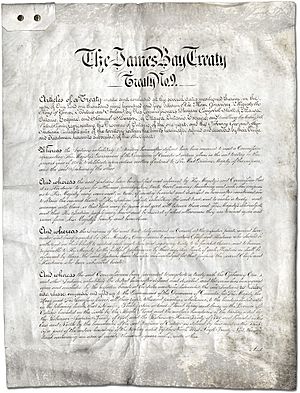Treaty 9 facts for kids
| The James Bay Treaty (Treaty No. 9) | |
|---|---|

The first page of the written document of The James Bay Treaty (Treaty No. 9).
|
|
| Signed | 12 July 1905 – 28 July 1930 |
| Parties |
|
| Language | English |
Treaty No. 9, also called The James Bay Treaty, is an important agreement signed between 1905 and 1906. It is one of the Numbered Treaties in Canada. This treaty was made between the Anishinaabe (including Algonquin and Ojibwe) and Omushkegowuk Cree peoples, and the Canadian Crown. The Canadian Crown represents both the government of Canada and the government of Ontario. This treaty is known as the "James Bay Treaty" because it covers land near James Bay in Northern Ontario.
Contents
Understanding Treaty 9
Why Was Treaty 9 Created?
In the early 1900s, the Canadian and Ontario governments wanted to manage the lands around Hudson Bay and James Bay. These areas in northern Ontario were the traditional homes of the Cree, Oji-Cree, and Ojibwe peoples. The governments were interested in these lands for various reasons, including their natural resources.
How Treaty 9 Was Signed
The governments of Canada and Ontario started discussing the treaty's details in May 1905. It took almost a year for Ontario to agree to begin these talks. Even though the Indigenous peoples needed to agree to the treaty, they were not part of writing the document. The terms of the treaty were also not allowed to change during the signing visits. One First Nations community from the Quebec region of Abitibi is also part of this treaty. More agreements, called "adhesions," were signed in 1929 and 1937. These included other Ojibwe and Swampy Cree communities.
Key Dates in Treaty 9 History
Here are some important dates when different communities signed Treaty 9:
- 29 June 1905: Duncan Campbell Scott and Samuel Stewart became treaty commissioners for Canada. Daniel G. MacMartin was the commissioner for Ontario. They traveled to different First Nations communities to hold signing ceremonies.
- 3 July 1905: Ontario and the Canadian government agreed to support Treaty 9.
- 12 July 1905: The Osnaburgh community signed.
- 19 July 1905: The Fort Hope community signed.
- 25 July 1905: The Marten Falls community signed.
- 3 August 1905: The Fort Albany community signed.
- 9 August 1905: The Moose Factory community signed.
- 21 August 1905: The New Post (Taykwa Tagamou Nation) community signed.
- 7 June 1906: The Abitibi community signed.
- 20 June 1906: The Matachewan community signed.
- 7 July 1906: The Mattagami community signed.
- 16 July 1906: The Flying Post (Flying Post First Nation) community signed.
- 19 July 1906: The Fort Hope community signed again.
- 25 July 1906: The Brunswick House community signed.
- 9 August 1906: The Long Lake community signed.
- 5 July 1929: The Big Trout Lake community signed.
- 18 July 1930: The Windigo River community signed.
- 25 July 1930: The Fort Severn community signed.
- 28 July 1930: The Winisk (Weenusk First Nation) community signed.
- 1995: Diaries from Daniel G. MacMartin, an Ontario treaty commissioner, were found. These diaries helped researchers understand more about the treaty signings.
Indigenous Communities of Treaty 9
Many First Nations communities are part of Treaty 9. Here is a list of some of them, grouped by where they originally signed:
|
|
Learning More About Treaty 9
The Treaty 9 Diaries Discovery
In 1995, the personal diaries of Daniel G. MacMartin were found. He was a commissioner for Ontario when Treaty 9 was signed. These diaries were over 100 years old and were found by historians at Queen's University. The diaries supported what Indigenous Elders had always said through their oral histories. They said that what the commissioners told them at the signings was different from what was written in the treaty document. This discovery of MacMartin's diaries led to a legal challenge. This challenge was about who had the right to use land for mining on First Nations territory. Murray Klippenstein, a lawyer for the Mushkegowuk Council, stated that the diaries suggested First Nation leaders might have been given incorrect information by government negotiators.
A Film About Treaty 9
The James Bay Treaty is also the topic of a documentary film. It was made in 2014 by Alanis Obomsawin and is called Trick or Treaty?.
See Also
- Nishnawbe Aski Nation
- Numbered Treaties
- Mushkegowuk Council
- The Canadian Crown and Indigenous peoples of Canada

